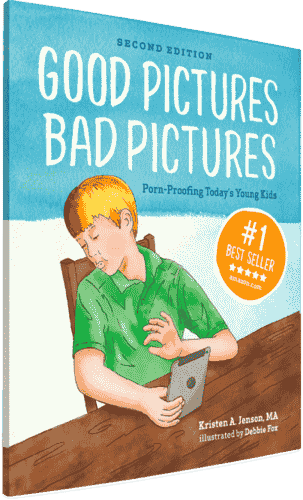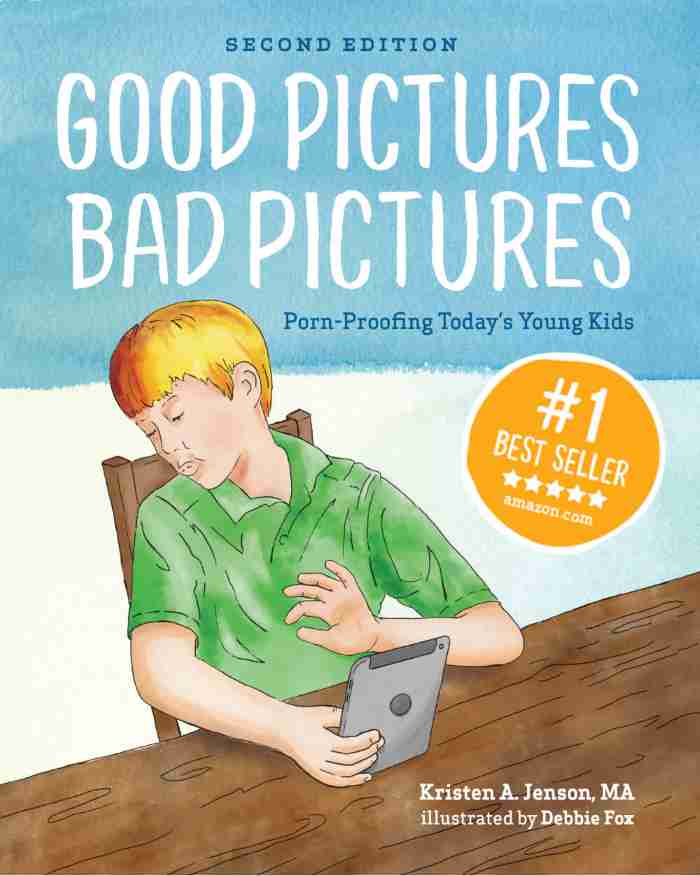
Helping the Kid Who Doesn’t Want Help
Nothing has caused me to feel more powerless than my little toddler. You’ve had those situations, right? Like the car seat.
It’s time to buckle in and she planks. A full-grown man hunched over a tiny girl, with no chance of success. I’m a big bad wolf blowing at a two-year-old brick house.

I tell her to stop (as if my desires weren’t already obvious). I explain how important it is to be a good listener (while I’m ignoring her protests). I remind her we’re in a hurry (even though she hasn’t yet developed a concept of time).
I want to help protect her, keep her safe, keep the family productive, efficient, and well... on-time. But the truth is, she isn’t buckling until she wants to buckle.
Kids often cause us to confront this very painful reality:
Sometimes kids don't want our help
The truth is that parents often care more about avoiding pornography than kids. Some kids are on board, but many aren’t. Some want to quit but are too embarrassed to talk. Others actually want pornography in their lives.
Frustrating as this is, I’m sure you can relate. Have your parents, boss, or spouse ever wanted something for you that you didn’t want? A different boyfriend, better grades, increased sales, more money, a colonoscopy?
The tension is real. We know what’s good for our kids--they just don’t always agree or simply don’t care.
This puts us in a tough bind
It seems we can either engage in the battle against our kids’ will (and suffer the consequences) or we can allow for their dysfunction (and suffer the consequences).
I’ll be honest. With the car seat, I’ve swung back and forth between coercion and giving up. Both feel terrible.
Do we force our kids’ hands through intensive restriction? There is healthiness in demanding high expectations. But on the other hand, this can foster resentment and defiance or evasiveness.
Well, do we just give in and allow them to drink poison? It honors their ability to choose. But left to their own devices (see what I did there?), they may fall in a pit they can’t escape from.
So what can we do when our kids aren’t cooperating with our anti-pornography campaign?
There is a middle way

Fortunately, like most dilemmas in life, that sweet spot in the middle is available--even if it is hard to find.
Here it is: focus on the bond. In other words, let the quality of the relationship be your highest goal.
If your child is closed off to discussing pornography then cultivating the relationship is important for two reasons.

First, secure attachment to caregivers is one of the strongest factors for childhood resilience, a key characteristic needed to overcome sexual problems. This is actually your best chance of helping them out of the problem. That’s right, sometimes pornography improves by moving attention away from pornography and onto the relationship.
The American Psychological Association has published a guide with additional tips and suggestions for cultivating resilience in children.
Second, even if they never choose to live by your standards of sexual discipline and respect, at least they won’t be swamped by pornography and alone at the same time. One problem is better than two problems.
Focusing on the relationship will either be the solution or will ease the lack of solution.
It works for car seats too, by the way. Rushing to buckle can last for ten loud and aggravating minutes. Pausing to listen to her needs and desires takes three minutes. It’s not the thirty-seconds I wish for, but once she feels heard she becomes much more cooperative (though not always happy).
Ready to focus on improving your relationship? Here are four simple ideas to get you started!
Related: 4 Ways to Help Kids Deal with Discomfort: Life Skills that Build Emotional Resilience
1) Find shared activities

Think of the Venn diagram where your interests overlap with your child’s interests. Schedule those times in. Whether that’s finding the best burger in town, mountain biking, or acting in local theater.
Don’t have any overlapping hobbies? Test-drive one of theirs. Try playing video games, talking philosophy, or at least let them play their favorite (appropriate) rap songs while doing Saturday chores. The more hours you can clock doing the same thing as your child, side-by-side, the better.
When my wife and I first got married we focused on finding hobbies that we could do together. I hated running, but if I went running I got to spend more time with my new bride. So I ran. I ended up running a couple half marathons and really came to enjoy it!
2) Talk about their interests
Interests are one step closer to feelings--and feelings are one step closer to longings. This is a way to draw closer to your kids’ hearts.
Start with straight-forward topics such as their passions, friends, or daily life. Your goal is simple: just listen.
Take on the role of the curious student. Let them teach you why anime matters to them or why it’s so upsetting that Angela is going to homecoming with Bryce.
For some, your kid may be guarded with even basic conversations. If you get sucked into giving advice (often experienced by teens as judgment) then remind yourself to act as an investigative reporter, objectively gathering information.
If they remain closed, experiment with sharing your own life with them in an honest way. Or guess what they may be experiencing and allow them to confirm or correct you. Just remember that listening often requires silence so be light on the pressure to talk.

What you learn may help you understand how your child sees the world. This may draw the two of you closer together.
Once you’ve opened up communication in straight-forward topics you can foray into challenges, flaws, and struggles. Talk about their hardest class, their loneliness, frustration with church, or being the shortest kid on the basketball team. Eventually, this may (may) lead to openness about sexual challenges.
Seriously, the number one longing that adolescents and teens (even the closed off ones) express in my therapy office is their parents’ understanding. They want parents to listen. That’s it.
[[CTA]]
3) Clarify expectations and outcomes
Whether communication is currently high or low, it’s helpful to have clear boundaries and expectations in the family.
Dr. John Townsend literally wrote the book on Boundaries. He describes three key results that occur when children have strong boundaries growing up: a sense of self, self-control, and great relationships.
Sometimes family rules are absent or chaotic. Even parents that teens describe as strict can sometimes have unclear boundaries; those teens may know that they regularly disappoint their parents but may not know exactly what’s okay and what’s not okay.
Related: Boundaries: Helping Kids Feel Safe
Along with outlining specific expectations, outline what will happen if those expectations are not met. What will you do if your child violates curfew? When do you take the phone away or the car keys? It helps to have these written out.
Most children groan when we set rules but most will adapt in time. When we know exactly what’s okay and what’s not okay (especially if we know what happens when we cross a line) the environment feels stable and predictable. This also gives our children the information they need to make informed choices and practice the art of decision-making.
Related: 6 Things Parents of Resilient Kids Do Well (and You Can Too!)
4) Reflect deeply on your interactions

Oftentimes the most helpful thing a parent can do is sit alone in silence.
As you review your recent interactions it will likely be clear what area you ought to focus on.
Identifying something that we wish was different doesn’t always mean we know the solution. If you feel lost, I’ve always found it helpful to seek out additional education. Books, podcasts, online articles, or talking with a mentor.
And, of course, knowing the solution doesn’t always mean we can implement it. Shifting your parenting style is challenging. Set up some accountability and pursue the change with grace.
Give yourself plenty of time for contemplation throughout the process. A ten-minute meditation or a quiet commute home has often given me insight. And just as often it leaves me with no answer but more peace.
What’s your next step?

Hopefully, something has been sparked for you. See if you can take these ideas and distill them down to your next action step.
This relational work can sometimes involve a long, slow process but it is absolutely the most efficient way to help your child grow and develop resilience to pornography and other life challenges.
Focus on the bond and you’ll find that the difficulties become much easier to bear.
This article was written in response to an email Protect Young Minds received from a mother who discovered her 12 year old son had been viewing pornography for about a year. Her son is now 14 and they are still working through this together. She feels their initial reaction as parents may not have been the best. She had three questions for us (paraphrased): 1. HOW DO I HELP MY SON? 2. HOW DO I REBUILD TRUST WITH MY SON AFTER OUR INITIAL REACTION? 3. HOW DO YOU TELL THE DIFFERENCE BETWEEN AN ADDICTION AND A HABIT?
For the first two questions, we turned to Taylor Chambers--a Licensed Marriage and Family Therapist who works with clients who have a pornography addiction. We think Taylor’s advice is helpful to all parents--no matter what their child is struggling with!
For the third question, here are some articles on addiction we’ve posted in the past:
Addiction Alert! 3 Facts Every Parent Needs to Know
How Porn Use Becomes an Addiction (Simplified!)
This Is Your Brain on Porn: 4 Videos to Help Kids Reject Addiction
If you have a child who is struggling with pornography, be sure to check out these articles as well:
What 10 Parents Learned When Their Child Was Caught in a Porn Trap [Part 1]
What 10 Parents Learned When Their Child Was Caught in the Porn Trap [Part 2]
What 10 Parents Learned When Their Child Was Caught in a Porn Trap [Part 3]



Good Pictures Bad Pictures
"I really like the no-shame approach the author takes. It's so much more than just 'don't watch or look at porn.' It gave my children a real understanding about the brain and its natural response to pornography, how it can affect you if you look at it, and how to be prepared when you do come across it (since, let's face it... it's gonna happen at some point)." -Amazon Review by D.O.







